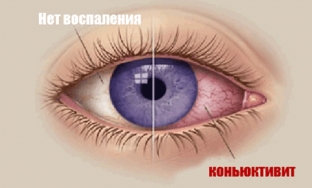Inflammatory process – It is the body's response to various environmental influences. Among many inflammatory diseases, conjunctivitis is one of the most common, since the mucous membrane of the eyelids – it is almost always an open and vulnerable part of the body. Conjunctivitis, that is, inflammation of the mucous membrane of the eyelids, occurs as a response to the action of an irritating agent, and is characterized by the development of conjunctival hyperemia and edema. The disease is often accompanied by the appearance of discharge from the conjunctiva, itching in the eyelids and, in some cases, decreased vision as a result of damage to the cornea.
Etiology of conjunctivitis: what could be the nature of the disease
Conjunctivitis is the main clinical form of eye infection. Among the many eye pathologies, conjunctivitis of various nature makes up about 30%. The most common are bacterial and viral conjunctivitis, somewhat less often allergic and dystrophic. An acute inflammatory process of the conjunctiva often affects children, much less often adults and the elderly. An important role in the development of the disease is played by the fact that infectious agents in most cases enter the mucous membrane of the eyelids directly through the hands of a person, which is why the best prevention of conjunctivitis is the minimum contact of hands or any objects with the eyes and the area around them.
Conjunctivitis:
- classification of conjunctivitis depending on the etiology of the disease;
- What role does anamnestic data play in determining the etiology of conjunctivitis?
- Laboratory methods for diagnosing conjunctivitis of various nature.
Classification of conjunctivitis depending on the etiology of the disease
Conjunctivitis, like many other diseases, can occur in two forms: acute and chronic. In accordance with the etiological factors that provoke the development of the disease, conjunctivitis is classified as follows:
- bacterial: catarrhal, pneumococcal, diphtheria, gonococcal and others;
- viral: herpetic, caused by common viral diseases, epidemics, etc.;
- allergic: spring catarrh, medicinal, hay fever and others;
- fungal: granulomatous in sporotrichosis, rhinosporidosis and actinomycosis, conjunctivitis in coccidosis, and so on;
- chlamydial conjunctivitis;
- conjunctivitis caused by common diseases, such as metastatic conjunctivitis.
What role does anamnestic data play in determining the etiology of conjunctivitis
Conjunctivitis is one of those diseases, for the correct diagnosis and clarification of the cause of the development of which a correctly collected anamnesis plays a very important role. There are such regularities:
- regardless of the etiology, all conjunctivitis have an almost similar clinical picture: acute onset, pronounced subjective sensations;
- patients complain of pain in the eyes, itching, the presence of discharge from the conjunctival cavity, damage to both eyes is characteristic;
- quite often the development of conjunctivitis, especially bacterial and viral, is associated with concomitant pathologies, such as otitis media or sinusitis;
- The combination of conjunctivitis with rhinorrhea, atopic exanthema, persistent cough or other allergic reactions may indicate its allergic nature.

Laboratory methods for diagnosing conjunctivitis of various nature
Laboratory diagnosis of conjunctivitis plays an important role in identifying the etiological factors of the disease and, accordingly, influences the choice of treatment method for the disease. With the help of cytological methods, it is possible to determine the causative agent of the disease in a scraping from the conjunctiva or an imprint smear from the cornea. The cultural method is used when the chlamydial nature of the disease is suspected, it allows you to isolate chlamydia and mycoplasmas in cell cultures. Serological tests are used much less frequently, they make it possible to evaluate the diagnostic titer of antibodies in the blood serum and determine the immunoglobulins of classes A and G in the lacrimal fluid.







Add a comment